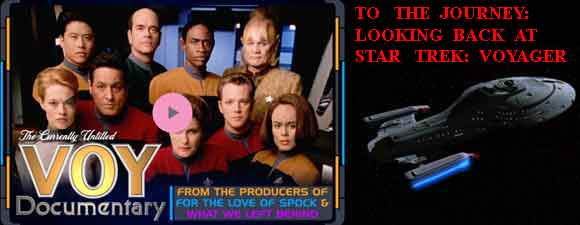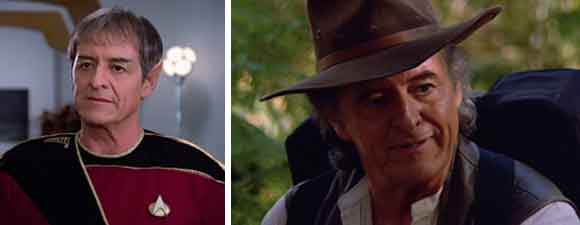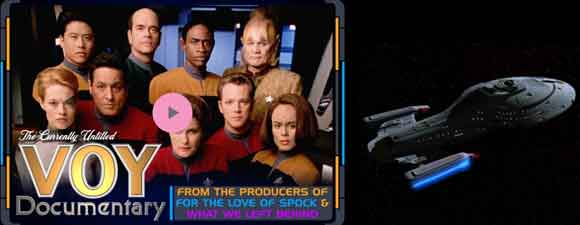Retro Review: Tattoo
7 min read
tattoo banner
Chakotay’s away team finds a carving similar to one used by his own tribe, triggering recollections of his youth.
Plot Summary: On an away mission to look for polyferranide, Chakotay discovers a spiral symbol carved in a rock. He explains to Janeway that it resembles the emblem of the Sky Spirits from an ancient myth he learned from his father, which claimed that his people were the descendants of powerful extraterrestrials. Chakotay has never believed the myth, but Janeway encourages him to consider the possibility that the story contains seeds of truth which might help them negotiate with whoever left the symbol on the planet. Voyager follows a warp trail to another M-class world that reminds Chakotay of Central America and contains polyferranide deposits beneath the surface, but when Torres tries to beam down an away team, storms arise in the atmosphere. Chakotay takes her, Tuvok, and Neelix down by shuttlecraft, but Neelix is attacked by a large bird, and another storm traps Chakotay on the surface as Tuvok and Torres return to the ship. Meanwhile, the Doctor experiments with experiencing illness to become more sympathetic to the struggles of flesh-and-blood patients. Alone on the planet, Chakotay explores a structure that reminds him of the ones he found with his father on a trip to Central America, where Chakotay first told his father that he didn’t belong among their superstitious tribe and wanted to enter Starfleet. He and his father encountered an isolated tribe with markings that didn’t appear human, who had the same tattoos on their forehead as Chakotay’s father bore – the one that Chakotay now wears to honor him. Entering a cave, Chakotay meets a group of humanoids who understand the few words he knows in what his father told him was the language of the Sky Spirits. They tell him that they settled many worlds but abandoned Earth when it appeared that all their descendants had been killed by violent humans. Chakotay explains that his own people left Earth for a planet where they could practice their own beliefs, though he himself rejected those beliefs until his father was killed. When Janeway tries to land Voyager to rescue Chakotay, the aliens refuse to allow the crew to take minerals from their planet but release the ship from the storms that threaten it.
Analysis: I really wanted to love this episode the first time I saw it, and I was determined to love it on a rewatch – so much to appreciate, after all, finally getting Chakotay’s backstory, exploring a human character who has a spiritual side after so many years of Star Trek mocking people with religious beliefs who don’t happen to be an Emissary to wormhole aliens, plus a gratuitous butt shot to top it off. But I can’t work up enthusiasm for anything besides the performances and some attractive visuals. There’s no getting around the laziness of the writing staff, who seem to believe that putting a label like “Native American” on a character is sufficient to count for diversity without doing any substantive research about Native American beliefs and customs. It’s not like Star Trek hasn’t done the same with other ethnic groups – “Scottish” and “Russian” are accents with stereotypes on the original series, while all African cultures have apparently been wiped out in favor of one big bland united continent – and it’s not like more recent genre entertainment hasn’t been just as lazy in rewriting Native American history with sci-fi gimmicks (see the big embarrassment known as Indiana Jones and the Kingdom of the Crystal Skull). Yet it’s still quite disappointing that a series which ran for seven years never gives any more substance to Chakotay than a backstory that echoes half the male characters in the franchise who reject their own traditions in favor of Starfleet, and a “Native American” history that’s the most irritating form of New Age American Indian nonsense, in which elements from different tribes are thrown together in a haphazard mash with the explanation that it’s because these special people and their accomplishments were brought about by powerful beings from outer space. I’m not sure whether to label this outright racism, since similar suggestions have been made about the tribes that built Stonehenge and other megalithic circles in ancient Britain, but it’s condescending and imperialistic.
It’s possible (though it would be nice to hear it explained) that after centuries of oppression and disregard by the settlers who took over the region and nearly wiped out the original residents, either actively through assault and forced integration or passively through disease and shortages created by poor care of the land, the remaining Native Americans chose to intermarry and merge their distinct traditions rather than witness their cultures disappearing one by one. Given the large cultural melting pots we’ve seen elsewhere in Star Trek’s future, it makes sense that Chakotay might have been raised with both Lakota beliefs about the medicine wheel and Zapotec traditions concerning animal guides. But we don’t get even that much specificity, just the implication that all Native Americans talk to animals and believe in the same afterlife. And, like Chakotay, our initial reaction to this is meant to be scorn. We’re told that Chakotay had no use for his own people’s traditions or values until his father’s death – not, it seems, because his father was overbearing or cruel to him like Spock’s, Riker’s, Paris’s, et al, but because he didn’t enjoy being dragged on field trips through rainforests or being told how much he owed to his ancestors. He had to feel such guilt over his father’s murder at the hands of the Cardassians that he not only rejected the Federation for allowing it to happen, but his own initial skepticism. And if he remains doubtful, as he tells Janeway, then why has he encouraged her to contact her animal guide and taught Torres about his medicine wheel? The writers are trying to have it both ways – to make Chakotay representative of some vague surviving Native American culture without having to explore the value of any given set of Native American beliefs. Kolopak calls him contrary, yet Chakotay comes off as reactive rather than active, relieved to have an excuse to follow Starfleet regulations again, preferring the indulgences of 24th century living to the traditions of the Rubber Tree People (the Olmecs? or is it just a similar name?).
How odd that in an episode focused on Chakotay, there’s more character development for the Doctor in the comic side story in which he programs himself to become ill after Kes accuses him of insensitivity to his patients. Yet again, Kes comes across as the most emotionally mature person on the ship despite her youth and inexperience. Perhaps Chakotay should try talking to her instead of to animals, because although we learn many things Chakotay does not believe, we still aren’t sure of the things he does. This “peaceful man from a peaceful people” fought in the Maquis to avenge his father. We’ve been told of his Maquis fellows that Paris was a private mercenary, Tuvok was a Starfleet spy, Seska was a Cardassian spy, and Torres was a Federation malcontent, so it’s rather disturbing to learn that even the leader of the group had no deep commitment to the Maquis cause after the Federation bartered away the home in which he had no interest in living. It suggests that most affiliation with the Maquis is based not on principle but personal interest – vengeance or bitterness or frustration – which in turn suggests that Starfleet and the Federation are in the right to consider them enemies. We’ve seen more ideologically committed Bajorans in the Maquis, like Ro and Gerron, than we’ve seen DMZ settlers. Maybe deep down Chakotay has concluded that the Federation was right – that going to war over a comparatively small number of colonists wasn’t worth risking millions of lives, which would explain why it has been so easy for him to return to Starfleet – but it’s hard not to miss the more conflicted, more aggressive character from “Parallax.” Chakotay’s finest moments of conflict in “Tattoo” are also the scenes of greatest intimacy, in which he tells Janeway about his family conflicts and struggle with the beliefs that he previously presented to her as powerful and personally defining. As usual, they stand a little too close and touch a little too often for work colleagues, and her encouragement more than his belief becomes the reason he pursues the link between his father’s spirituality and the strange symbol on the alien planet. Yet again, it appears that Janeway’s cause is Chakotay’s cause.







I can’t even be bothered to must up much more than saying “dreadful”.nnOkay I will… “truly dreadful”. A dire episode.
“SHHHHHAAAAAAAAAAAMMOWSAAAAAAAAAAYYYYYYYYYY!!!”
Thanks for the review. Chakotay was the most glaring example of an underutilized and dramatically squandered character in all of Trek…until Captain Archer. I really like both actors and both characters, but they were badly mishandled. Another two examples are the wastes they made of Gul Dukat and Q, but each of them had many classic tales before they were misused. There’s no excuse for neglecting them, week after week, for years. Too bad this wasn’t a good ep.
And yet, it got an award from a First Nations group. Make of that what you will.
I’m glad someone found it culturally relevant or sensitive, somehow. Star Trek has always been a deeply mixed bag of social consciousness. Feminists appreciated how Uhura was on the bridge crew, and contributing to the male-run leadership, so they looked past her demeaning uniform, perfunctory dialogue, and all around cringe-worthy similarity to a traditional secretary. I’m very happy to have people see these clumsy attempts at IDIC as uplifting and progressive, but we shouldn’t kid ourselves, or fail to see that Star Trek must aspire to be better than it is.
May I as what you were doing watching TOS in the first place, knowing what ’60’s TV was like? At least this episode (and ‘How Sharper Than A Serpent’s Tooth’ from TAS) did acknowledge First Nations customs and tradition, even if it was in a flawed way like this.
zzzzzzzzzz
I also always liked the notion set up near the end of TNG that some native Americans decided to find a planet of their own. It seemed fitting that a people who lost so much land would end up with an abundance of it to live on. Never heard any natives remark on whether they found it insulting or not, but I liked it. Of course they were clearly on the front lines of some Cardassian cruelty and Maquis uprising, so it wasn’t a total win…